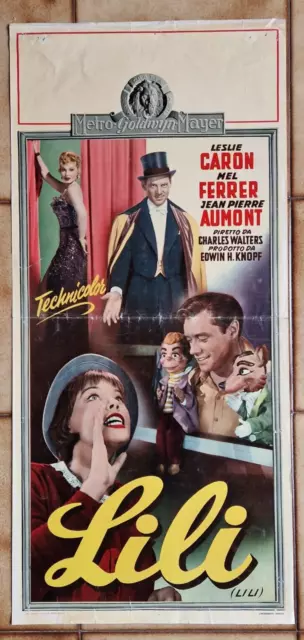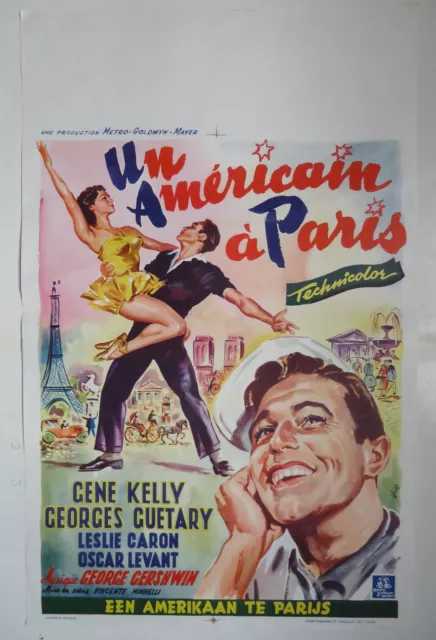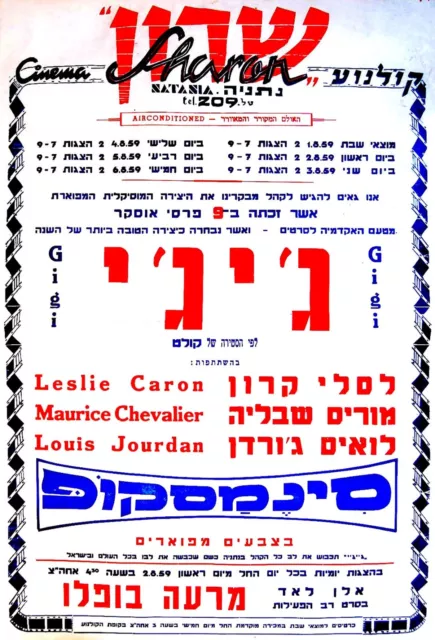1959 Israel GIGI Movie FILM POSTER Hebrew LESLIE CARON Chevalier MINNELLI Jewish
| DESCRIPTION : Here for sale is an EXCEPTIONALY RARE and ORIGINAL POSTER for the ISRAEL 1959 PREMIERE of the legendary ACADEMY and GOLDEN GLOBE AWARDS winner MUSICAL film "GIGI" in the small rural town of NATHANYA in ISRAEL. Starring LESLIE CARON , MAURICE CHEVALIER and LOUIS JOURDAN to name only a few . Directed by VINCENTE MINNELLI , Script and lyrics by ALAN JAY LERNER , Music and songs by FREDERICK LOEWE , Arranged and conducted by ANDRE PREVIN , Based on the novella by COLETTE . The cinema-movie hall " CINEMA SHARON" , A local Israeli version of "Cinema Paradiso" was printing manualy its own posters , And thus you can be certain that this surviving copy is ONE OF ITS KIND. Fully DATED 1959 . Text in HEBREW and ENGLISH . Please note : This is NOT a re-release poster but PREMIERE - FIRST RELEASE projection of the film , A year and half after its release in 1958 in the USA. The ISRAELI distributors of the film have given it a quite archaic and amusing HEBREW text . The poster also advrtises an ALAN LADD film in matinee show. GIANT size around 24" x 38" ( Not accurate ) . Printed in red and blue . The condition is very good . ( Pls look at scan for accurate AS IS images ) Poster will be sent rolled in a special protective rigid sealed tube. AUTHENTICITY : The POSTER is fully guaranteed ORIGINAL from 1959 , It is NOT a reproduction or a recently made reprint or an immitation , It holds a with life long GUARANTEE for its AUTHENTICITY and ORIGINALITY. PAYMENTS : Payment method accepted : Paypal & All credit cards. SHIPPMENT : SHIPP worldwide via registered airmail is $ 25 . Poster will be sent rolled in a special protective rigid sealed tube. Handling around 5-10 days after payment.
|
- Condition: Used
- Condition: The condition is very good . ( Pls look at scan for accurate AS IS images )
- Size: GIANT size around 24" x 38" ( Not accurate )
- Country/Region of Manufacture: Israel
- Movie: "GIGI"
- Original/Reproduction: Original
- Year: 1950-59
- Object Type: Poster
- Industry: Movies
PicClick Insights - 1959 Israel GIGI Movie FILM POSTER Hebrew LESLIE CARON Chevalier MINNELLI Jewish PicClick Exclusive
- Popularity - 3 watchers, 0.0 new watchers per day, 116 days for sale on eBay. High amount watching. 0 sold, 1 available.
- Best Price -
- Seller - 2,810+ items sold. 0% negative feedback. Great seller with very good positive feedback and over 50 ratings.
People Also Loved PicClick Exclusive

Gigi 9 Oscar 1Sh Minnelli Maurice Chevalier Leslie Caron 1958 Exyu Movie Poster
£129.14 Buy It Now 27d 6h
Afiche original.- GIGI - 1959 - LESLI CARON - 75X110-cm
£176.70 Buy It Now 28d 4h
Lili Leslie Caron Mel Ferrer Walters Italian Movie Poster First Release 1953
£95.41 Buy It Now 25d 23h
GABY Leslie Caron John Kerr original belgian movie poster '56
£66.50 Buy It Now 12d 22h
GENE KELLY+LESLIE CARON/AN AMERICAN IN PARIS /U18J/ belgian poster
£106.02 Buy It Now 2d 4h


